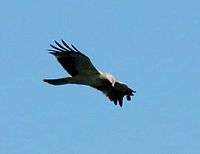Wahlberg's eagle
| Wahlberg's eagle | |
|---|---|
 | |
| Photographed in the Kruger National Park, South Africa | |
| Scientific classification | |
| Kingdom: | Animalia |
| Phylum: | Chordata |
| Class: | Aves |
| Order: | Accipitriformes |
| Family: | Accipitridae |
| Genus: | Hieraaetus |
| Species: | H. wahlbergi |
| Binomial name | |
| Hieraaetus wahlbergi (Sundevall, 1851) | |
| Synonyms | |
| |
Wahlberg's eagle (Hieraaetus wahlbergi) is a bird of prey that is native to sub-Saharan Africa, where it is a seasonal migrant in the woodlands and savannas. It is named after the Swedish naturalist Johan August Wahlberg. Like all eagles, it belongs to the family Accipitridae.
Description

Wahlberg's eagle is a medium-sized raptor, and the sexes are similar. It is about 53–61 cm (21–24 in) in length with a wingspan of 130–146 cm (51–57.5 in) and a body mass of 437–845 g (15.4–29.8 oz) for males and 670–1,400 g (1.48–3.09 lb) for females on average. The head has a small crest, and the legs are yellow. The plumage tone is variable but may be dark brown except for dark-streaked grey undersides to the flight feathers, and a barred grey undertail. Light and dark plumage phases occur. A pale variant may be much lighter brown with whitish, rather than grey undertail and flight feather undersides.
While the large brown eagles are generally a tricky group to identify, Wahlberg's eagle have some distinctive features. A small, pointed crest is usually visible. The gape only extends at maximum to the middle of the eye, whereas in lesser spotted eagle, it extends to the back of the eye. Round nostrils are not present in either tawny or steppe eagles, but the two spotted eagles also have round nostrils. In flight, this species is very cross-shaped, with long, evenly wide wings, a slim body, and a narrow, square-ended tail. The wings are held very flat.
Behaviour
Wahlberg's eagle hunts reptiles, small mammals, and birds. The call is a whistled kleeah-kleeah-kleeah, while perched.
Nesting
Wahlberg's eagle breeds in most of Africa south of the Sahara. It is a bird of woodland, often near water. It builds a stick nest in the fork of a tree or the crown of a palm tree. The clutch is one or two eggs.
Taxonomy
Studies of marker gene sequences (published 2004–2005) found Wahlberg's eagle belonged to a clade containing Hieraaetus pennatus, H. morphnoides, H. ayeresii, and H. (m.) weiskei.[2][3][4] Since then, many taxonomic checklists changed from Aquila wahlbergi to Hieraaetus wahlbergi.[5][6][7][8] However, the African Bird Club (as of the 2012 checklist) and the Second Southern African Bird Atlas Project (as of 2014) continue to keep Aquila wahlbergi separate from the Hieraaetus species.[9]
References
- ↑ BirdLife International (2014). "Hieraaetus wahlbergi". IUCN Red List of Threatened Species. Version 2014.2. International Union for Conservation of Nature. Retrieved 6 October 2014.
- ↑ Helbig, Andreas J.; Kocum, Annett; Seibold, Ingrid; Braun, Michael J. (2004). "A multi-gene phylogeny of aquiline eagles (Aves: Accipitriformes) reveals extensive paraphyly at the genus level". Molecular Phylogenetics and Evolution. 35 (1): 147–164. doi:10.1016/j.ympev.2004.10.003. PMID 15737588.
Wahlberg’s Eagle H. wahlbergi, formerly placed in Aquila, is part of a clade including three small Hieraaetus species (pennatus, ayresii, and morphnoides)
- ↑ Wink, Michael; Sauer-Gürth, Heidi (2004). "Phylogenetic relationships in diurnal raptors based on nucleotide sequences of mitochondrial and nuclear marker genes". In Chancellor, R. D.; Meyburg, B.-U. Raptors Worldwide. WWGBP/MME. pp. 483–498. PDF alternate location
- ↑ Lerner, Heather R. L.; Mindell, David P. (2005). "Phylogeny of eagles, Old World vultures, and other Accipitridae based on nuclear and mitochondrial DNA". Molecular Phylogenetics and Evolution. 37 (2): 327–346. doi:10.1016/j.ympev.2005.04.010. PMID 15925523. PDF alternate location
- ↑ Le Page, Denis. "Wahlberg's eagle". Avibase Taxonomic Concepts. Retrieved 5 October 2014.
Note that, in addition to Clements and Birdlife International, Avibase lists the following authorities as using H. wahlbergi:- Commission internationale pour les noms français des oiseaux (1993, révision 2009)
- Howard & Moore (2nd and 3rd editions)
- IOC World Bird Names (from version 2.0)
- Zoonomen
- ↑ The Clements Checklist team (23 December 2009). "Updates & Corrections – December 2009". The Cornell Lab of Ornithology. Retrieved 21 June 2014.
Pages 47-48, Wahlberg’s Eagle Aquila wahlbergi, Booted Eagle Aquila pennata, Little Eagle Aquila morphnoides, Ayres’s Hawk-Eagle Aquila ayresii. All of these eagles belong in the genus Hieraaetus
- ↑ BirdLife Taxonomic Checklists listed A. wahlbergi in versions 0 (2007) through 6.1 (February 2014). From version 7 (July 2014), their taxonomy of non-passerines is based on del Hoyo et al. 2014, and Wahlberg's eagle is listed as H. wahlbergi. All versions available via "Taxonomy". BirdLife International. Archived from the original on 2014-09-24. Retrieved 5 October 2014.
- ↑ Boyd, John. "Accipitrimorphae". Taxonomy in Flux Checklist. Retrieved 5 October 2014.
- ↑ African Bird Club continues to use A. wahlbergi, as does SABAP2. However, BirdLife South Africa (formerly South African Ornithological Society) uses H. wahlbergi in its 2014 checklist. Note that ABC and SABAP2 still recognize genus Hieraaetus, they just don't include Wahlberg's eagle in it. This is different from some other authors who merged all of Hieraaetus into Aquila. See the Hieraaetus article for further discussion of this merger.
| Wikimedia Commons has media related to Hieraaetus wahlbergi. |
| Wikispecies has information related to Hieraaetus wahlbergi |
- Birds of The Gambia by Barlow, Wacher and Disley, ISBN 1-873403-32-1
External links
- Wahlberg's eagle - Species text in The Atlas of Southern African Birds
